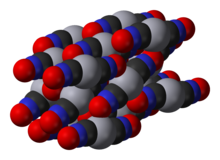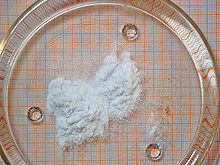Mercury(II) fulminate

| |

| |

| |
| Names | |
|---|---|
| Other names
Fulminated Mercury
| |
| Identifiers | |
3D model (JSmol)
|
|
| ChEBI | |
| ChemSpider | |
| ECHA InfoCard | 100.010.053 |
PubChem CID
|
|
CompTox Dashboard (EPA)
|
|
| |
| |
| Properties | |
| C2N2O2Hg | |
| Molar mass | 284.624 g/mol |
| Appearance | Grey, Pale Brown, or White Crystalline solid |
| Density | 4.42 g/cm3 |
| Melting point | 160°C |
| Boiling point | 356.6°C |
| slightly soluble | |
| Solubility | soluble in ethanol, ammonia |
| Explosive data | |
| Shock sensitivity | High |
| Friction sensitivity | High |
| Hazards | |
| Occupational safety and health (OHS/OSH): | |
Main hazards
|
Highly Toxic, Shock Sensitive Explosive |
Except where otherwise noted, data are given for materials in their standard state (at 25 °C [77 °F], 100 kPa).
| |
Mercury(II) fulminate, or Hg(CNO)2, is a primary explosive. It is highly sensitive to friction and shock and is mainly used as a trigger for other explosives in percussion caps and blasting caps. Mercury(II) cyanate, though its formula is identical, has a different atomic arrangement; the cyanate and fulminate anions are isomers.
First used as a priming composition in small copper caps after the 1830s, mercury fulminate quickly replaced flints as a means to ignite black powder charges in muzzle loading firearms. Later, during the late 19th century and most of the 20th century, mercury fulminate or potassium chlorate became widely used in primers for self-contained rifle and pistol ammunition. Mercury fulminate has the distinct advantage over potassium chlorate of being non-corrosive, but it is known to weaken with time. Today, mercury fulminate has been replaced in primers by more efficient chemical substances. Those are non-corrosive, less toxic and more stable over time: lead azide, lead styphnate and tetrazene derivatives. In addition, none of these compounds replacing Hg(II) fulminate requires mercury for manufacture, supplies of which can be unreliable in wartime.[citation needed]
Preparation
Mercury(II) fulminate is prepared by dissolving mercury in nitric acid and adding ethanol to the solution. It was first prepared by Edward Charles Howard in 1800.[1] The crystal structure of this compound was only determined in 2007.[2]
Silver fulminate can be prepared in a similar way, but this salt is even more unstable than mercury fulminate; it can even explode under water and is impossible to accumulate in large amounts because it detonates under its own weight.
Decomposition
The thermal decomposition of mercury(II) fulminate can begin at temperatures as low as 100°C, though it proceeds at a much higher rate with increasing temperature.[3]
A possible reaction for the decomposition of mercury(II) fulminate yields carbon dioxide gas, nitrogen gas, and a combination of relatively stable mercury salts.
- Hg(CNO)2 → CO2 + N2 + HgO + Hg(OCN)CN
In popular culture
On AMC's Breaking Bad, Walter White throws a piece of fulminated mercury to the floor to cause an explosion at Tuco Salamanca's hangout. The effect demonstrated in the scene, while theoretically plausible, is generally considered to have been exaggerated for dramatic effect. [4]
In Law & Order's Season 7, Episode 6 "Double Blind" the killer uses bullets tipped with fulminated mercury to kill a former school janitor.
In Burn Notice's Season 4, Episode 13 "Eyes Open" Michael Westen uses decoy Mercury Fulminate in order to distract a bomb man while Sam Axe searches his house.
In the movie Mister Roberts, Jack Lemmon's character Ensign Pulver uses "fulminate of mercury" to create a very large "firecracker."
In the eighth episode of the anime Code Geass, the Japanese Liberation Front uses a Mercury (II) Fulminate cannon as an anti-Knightmare long range weapon.
References
- ^ Edward Howard (1800). "On a New Fulminating Mercury". Philosophical Transactions of the Royal Society of London. 90 (1): 204–238. doi:10.1098/rstl.1800.0012.
- ^ W. Beck, J. Evers, M. Göbel, G. Oehlinger and T. M. Klapötke (2007). "The Crystal and Molecular Structure of Mercury Fulminate (Knallquecksilber)". Zeitschrift für anorganische und allgemeine Chemie. 633 (9): 1417–1422. doi:10.1002/zaac.200700176.
{{cite journal}}: CS1 maint: multiple names: authors list (link) - ^ W. E. Garner & H. R. Hailes (1933). "Thermal decomposition and detonation of mercury fulminate". Proceedings of the Royal Society of London. 139 (1–3): 1–40. Bibcode:1933CP....334..128S. doi:10.1098/rspa.1933.0040. Retrieved 2013-03-11.
- ^ http://chemistry.about.com/b/2008/03/05/mercury-fulminate-breaking-bad.htm
